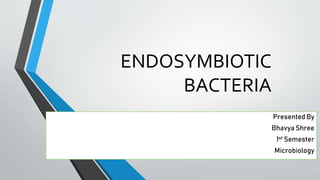Endosymbiotic bacteria
•Descargar como PPTX, PDF•
0 recomendaciones•62 vistas
This document discusses endosymbiotic bacteria and their relationships with host cells and organisms. It proposes that some eukaryotic organelles like mitochondria and plastids evolved from engulfed prokaryotes. There are two main types of endosymbiosis - primary involving one symbiont and secondary involving symbionts that already underwent primary endosymbiosis. Examples include rhizobium bacteria that form nodules on legume roots in exchange for nutrients, and wolbachia bacteria that manipulate insect reproduction while protecting the host from viruses. Endosymbiotic bacteria can have beneficial relationships with their hosts by providing nutrients or protecting against pathogens.
Denunciar
Compartir
Denunciar
Compartir

Recomendados
Recomendados
Más contenido relacionado
La actualidad más candente
La actualidad más candente (20)
Host parasite relationship ,interaction & mechanism of

Host parasite relationship ,interaction & mechanism of
Similar a Endosymbiotic bacteria
Similar a Endosymbiotic bacteria (20)
Different modes of reproduction of fungi and reproductive structure and nutri...

Different modes of reproduction of fungi and reproductive structure and nutri...
Último
Último (20)
Role of AI in seed science Predictive modelling and Beyond.pptx

Role of AI in seed science Predictive modelling and Beyond.pptx
Porella : features, morphology, anatomy, reproduction etc.

Porella : features, morphology, anatomy, reproduction etc.
The Mariana Trench remarkable geological features on Earth.pptx

The Mariana Trench remarkable geological features on Earth.pptx
Cyathodium bryophyte: morphology, anatomy, reproduction etc.

Cyathodium bryophyte: morphology, anatomy, reproduction etc.
POGONATUM : morphology, anatomy, reproduction etc.

POGONATUM : morphology, anatomy, reproduction etc.
Asymmetry in the atmosphere of the ultra-hot Jupiter WASP-76 b

Asymmetry in the atmosphere of the ultra-hot Jupiter WASP-76 b
Use of mutants in understanding seedling development.pptx

Use of mutants in understanding seedling development.pptx
LUNULARIA -features, morphology, anatomy ,reproduction etc.

LUNULARIA -features, morphology, anatomy ,reproduction etc.
Site specific recombination and transposition.........pdf

Site specific recombination and transposition.........pdf
Module for Grade 9 for Asynchronous/Distance learning

Module for Grade 9 for Asynchronous/Distance learning
Selaginella: features, morphology ,anatomy and reproduction.

Selaginella: features, morphology ,anatomy and reproduction.
Endosymbiotic bacteria
- 1. ENDOSYMBIOTIC BACTERIA Presented By Bhavya Shree 1st Semester Microbiology
- 2. Endosymbiotic theory This theory was first proposed by Russian botanist Konstantin Mereschkowski in 1905 . He was propose Symbiogenesis or Endosymbiotic theory . This theory states that “ Some eukaryotic cell orgenelles , such as mitochondria and plastids , which are evolved from free living prokaryotes “ .
- 3. Define Symbiogenesis ? It is the leading evolutionary theory of the origin of eukaryotic cells from prokaryotic organisms . What is endosymbiosis ? It is a symbiosis ,in which one symbiont dwells with in the body of the other is called endosymbiosis .
- 5. Types of endosymbiosis 1.Primary endosymbiosis 2.Secondary endosymbiosis Primary endosymbiosis 1.The process in which a eukaryotic cell engulfs another living prokaryote. 2.Thought to have occurred first. 3.Either cell does not depend on each other. 4. Results in the formation of the first membrane , which belongs to the smaller cell. Secondary endosymbiosis 1.The process in which a eukaryotic cell engulfs another eukaryotic cell that has already undergone primary endosymbiosis . 2.They are occurred later. 3.The smaller cell depends on the larger cell. 4.Results in the formation of three plasma membranes , like the first membrane which is originating from cyanobacteria , second membrane is the eukaryote that engulfed the cyanobacteria ,and third membrane from the eukaryote which is engulfed the primary endosymbiotic eukaryote.
- 6. What are endosymbionts ? Endosymbionts are organisms that from a symbiotic relationships with another cell or organisms is called endosymbionts . Some endosymbionts can be found either inside cell is called Intracellular. Some are attach to the surface of the cell is called Extracellular . Example :- In the corals, the host animal is a cnidarin and the endosymbiont is a unicellular alga called dinoflagellate .The host serves as a protected environment providing the alga with a constant supply of nutrients in the form of nitrogen ,phosphorus and sulfur . Beneficial relationship between both host and endosymbiont .
- 7. Endosymbiotic events • 1 .Enzymes • 2.Photosynthesis • 3.Chloroplast • 4.Adenosine triphosphate • 5.Phylogenetics • 6.Mitochondria • 7.Apicoplast • 8.Globin
- 8. Example Endosymbiotic bacteria in plants Symbiosis between Rhizobium bacteria and legumes plants which leads to formation of the root nodule .The endosymbiotic bacteria in polyploid host cells as membrane which is surrounded by vesicle , where they reduce atmospheric nitrogen to support plant growth by supplying ammonia in exchange for carbon sources and energy .
- 9. Why Rhizobium is play role as endosymbiotic bacteria in plants ? • Rhizobium can not prepare its own food ,it establishes it self in the roots of the plants and provides nutrients for plants . In turn plants provide the bacteria with food and shelter.
- 10. Rhizobium bacteria in plants
- 11. Endosymbiotic bacteria in insects Endosymbionts are vertically transmitted from mother to offspring and they provide hosts with specific nutritional compounds that are important for their survival and development . Wolbachia is a maternally transmitted bacterium that lives inside arthropod cells. Parasite that manipulates host reproduction but more recently ,it discovered that Wolbachia can also protect Drosophila species against infection by RNA virus . It is also present in insects ,butter flies ,bees . Wolbachia infection turns unfertilized eggs into diploid , which those are hatch into females .This means that infected females produce daughters from both fertilization and parthenogenesis .
- 12. WhyWolbachia is play roles as endosymbiotic bacteria in insects ? • In arthropods Wolbachia producers reproductive manipulations such as male killing , fertilization , parthenogenesis , and cytoplasmic incompatibility for its propagation and provides an additional fitness benefit for the host to protect against pathogens .
- 13. Wolbachia bacteria in insects
- 14. Conclusion • Bacteria is lives inside the host cell , symbiont which specific functions to host cell . Both are in benificial relationship and does not harm to anyone .
- 15. Reference • 1. Endosymbiotic theories of organelles – Naoki sato • 2. Case study in cell biology - Merrilynm casem